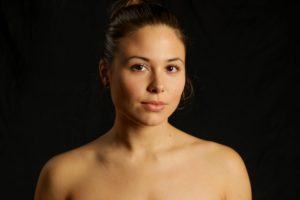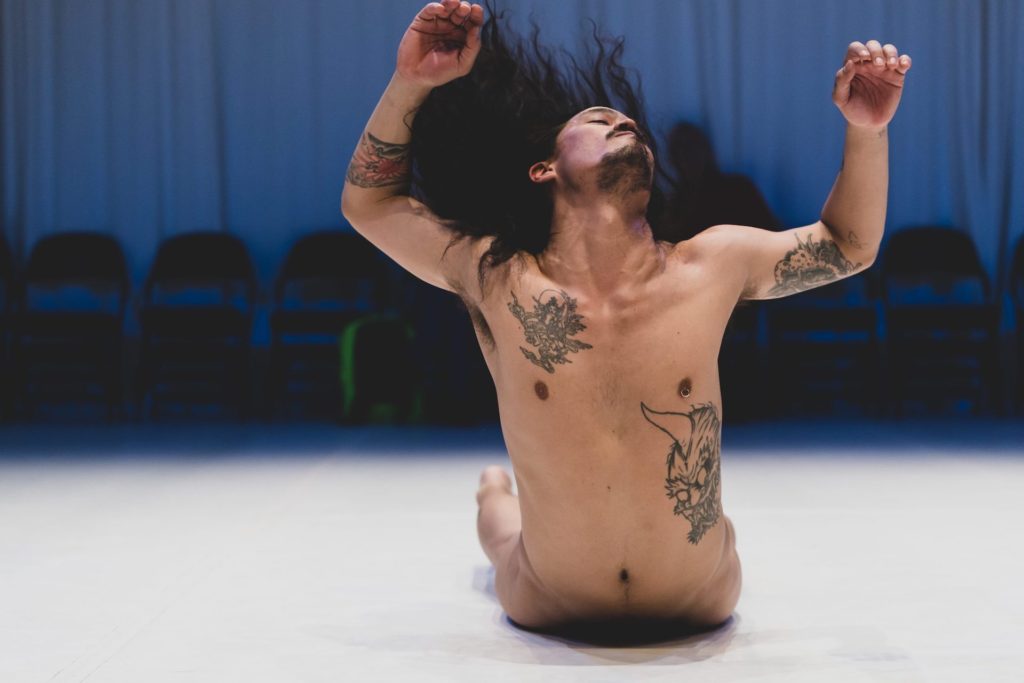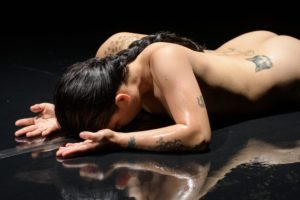Featured at Montpellier: Daina Ashbee in powerful view - Vancouver Ballet Society
- Home
- Features 2020 - 2023
- Featured at Montpellier: Daina Ashbee in powerful view

By Philip Szporer
Daina Ashbee is a smart, powerful Montreal-based dance artist with Cree, Métis and Dutch heritage, gaining significant traction in her career. She’s been building a devoted following, international touring and accolades, like the 2019 Bessie (a New York Dance and Performance Award) for Outstanding Breakout Choreographer. This summer, the Festival Montpellier Danse is bestowing the 30-year-old with a prestigious platform, presenting a slate of five of Ashbee’s works. When I spoke with Montpellier Danse general director Jean-Paul Montanari, he called her a “magician,” and said he’s confident this “launchpad” will propel her to further engagements in Europe. He similarly boosted the trajectory of some now well-known artists such as Boris Charmatz and Jérôme Bel.
In early May, I reached Ashbee on Zoom in the Mexican jungle, where she was on a residency retreat. She recalls meeting with Montanari at the 2018 edition of Montreal’s Festival TransAmériques. At the time, her work was touring extensively, and she was about to be featured at the Venice Biennale. “I was late and crying and doing too many things. We talked about our childhoods.” The two met again the next year and plotted to bring her solo works to the Montpellier festival in 2020. COVID-19 got in the way of that plan, but the Ashbee retrospective is now on course for this summer’s event, June 23-July16.

Ashbee grew up in her birthplace, Nanaimo, British Columbia, as well as on nearby Gabriola Island. There, during these formative years, she was surrounded by nature, with sandstone beaches, craggy cliffs, forest and coastal vistas. She started to rediscover and value her aboriginal legacy in her teens. Her sculptor father, who created traditional transformation masks, which bring about healing, made his culture come alive for his daughter.
Eating disorders were also part of her adolescent life. She says she didn’t “want to take up too much space in the world,” and talks about a desire to heal and care for others after witnessing a lot of suffering, with alcohol and drugs destroying people’s lives. Against this onslaught of impermanence and noise, Ashbee saw the value of discipline. She sought out dance. Michael Jackson was an early inspiration, and she would follow dance steps on MuchMusic videos. “I didn’t know my left foot from my right,” she laughs.
Still she loved singing and dancing and moved to Vancouver at 16 to train at Modus Operandi, and then danced with Raven Spirit Dance. Yet, because she was extremely shy, she indicates she felt alone. “I’d never had many opportunities, but I was full of ideas. And full of anger,” she says, adding, “I had no expectations to fulfill.” Choreography and creation were always on her mind, but she felt that she “had to be good at dancing first.” Improvising came naturally, and she never lacked for images playing in her head.
At 21, Ashbee experienced a traumatic event, and fell into a depression. Her body, she says, was frozen. She couldn’t dance and funnelled her creativity through writing in notebooks. She submitted an arts council grant application, which led to Unrelated (2014). Dreams and images of working with women were ever-present. By the time she arrived in Montreal, she says, “I didn’t have a lot of belief in myself… People saw I was doubtful, vulnerable.”

In her adopted city, Ashbee learned French, and got a job teaching yoga. “I began to heal my relationship with my body through yoga.” Michael Toppings, director of the MAI (Montréal, arts interculturels), gave her a mentorship technical residency. “Sculpting the space was rewarding,” she says. Stepping out of the dancing, she discovered she loved directing. Over time, she’s learned to detach, “to not be lost inside my feelings and to create in the external space outside of me. To protect myself, I’ve learned to make things more abstract.”
Ashbee reframes indigeneity in her practice, offering intimate performances, where pain, violence, defiance, strength, vulnerability and transformation manifest in the body. As the intimacy and mystery of her work intensifies, she trains the eye of the viewer through repetition, building patience, changing the way that spectators look at dance.
Even though he had seen only one of her works, Montanari reveals that he was intuitively drawn to Ashbee, and they hit it off immediately. “She is a young artist with a charm, very direct, simple but demanding.” Ashbee describes herself as “a perfectionist and ambitious,” striving to make a difference.

Missing and murdered Indigenous women and girls are the subject matter of Unrelated, the earliest piece in the Ashbee retrospective at Montpellier, in which the aggregate suffering and darkness in the work is laid bare for audiences. At the time, Ashbee says, “I had this violence and self-destruction in my body, and this was coming out in the movement. I wanted to put what was building inside of me out.” Honest and unflinching, at its premiere the work detonated, with its dancers, nude, providing a vulnerability to sustained sections of violence, achieved through hitting, falling and slapping.
The other retrospective works, discussed below, are also radical and riveting, mapping women’s bodies and issues: female sexuality, anorexia, trauma, violence, loss and menstrual cycles. Nudity in performance can be a challenge or a provocation; in Ashbee’s work, skin is empowering. She elevates the body, women’s bodies in particular, in a very physical sense. Her work is an act of retrieval, replacing what is lost.
2016’s Pour (think the English verb, and not the French “for”) exposes menstruation “in order to un-censor women’s pain and stories,” Ashbee says. “It’s really scary navigating the world when you’re young and hormonal. You don’t feel free to bleed every month.” In this solo, she connects the cycles of blood, life and death, ice and water, carefully inscribing what she calls “stillness and moving energy.”
The urgently titled installation When the ice melts, will we drink the water? (2016) interrogates “the rape of the world,” she says, the crisis of climate change and its effect on Indigenous communities. More incisively, Ashbee probes the violence against the environment in relation to a woman occupying space in society.
Serpentine (2017), a two-hour loop, builds cycles of repetition and literal violence. It is, says Ashbee, “a brutal, insistent piece about endurance, living every day in a cycle of struggling and finding a reason to go again.”
Finally, Laborious Song (2020) peels away at human fragility, probing vulnerability and an exploration of inner sensitivities, through trance and transformation, this time created with a male interpreter.
Ashbee admits that prior to her career success, she had never really travelled. Acclaim begat presenting opportunities in Europe but, at first, she says, she was “unable to embrace the old buildings and colonialization.” Then those thoughts and emotions altered, and “I saw what was being given was a gift.” Montpellier provides such an opening, with Montanari’s programming relying on his profound sense about this contemporary Indigenous artist. “I’ve built my career on intuition and building trust with the artists,” he says.
Ashbee is feeling the transformative effects transmitted through the care and support of people like Montanari, “and not having to do everything by myself.” It’s made her healthier and stronger. Looking forward with a newfound certitude, Ashbee says, “I have to trust the universe is in control. I still go with the flow but, like a surfer, I ride the waves.”

